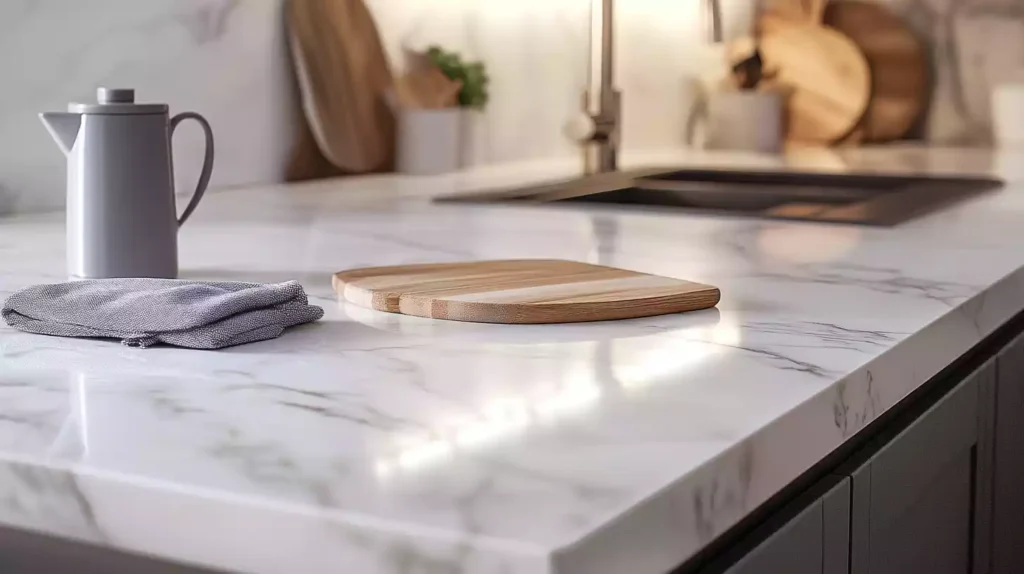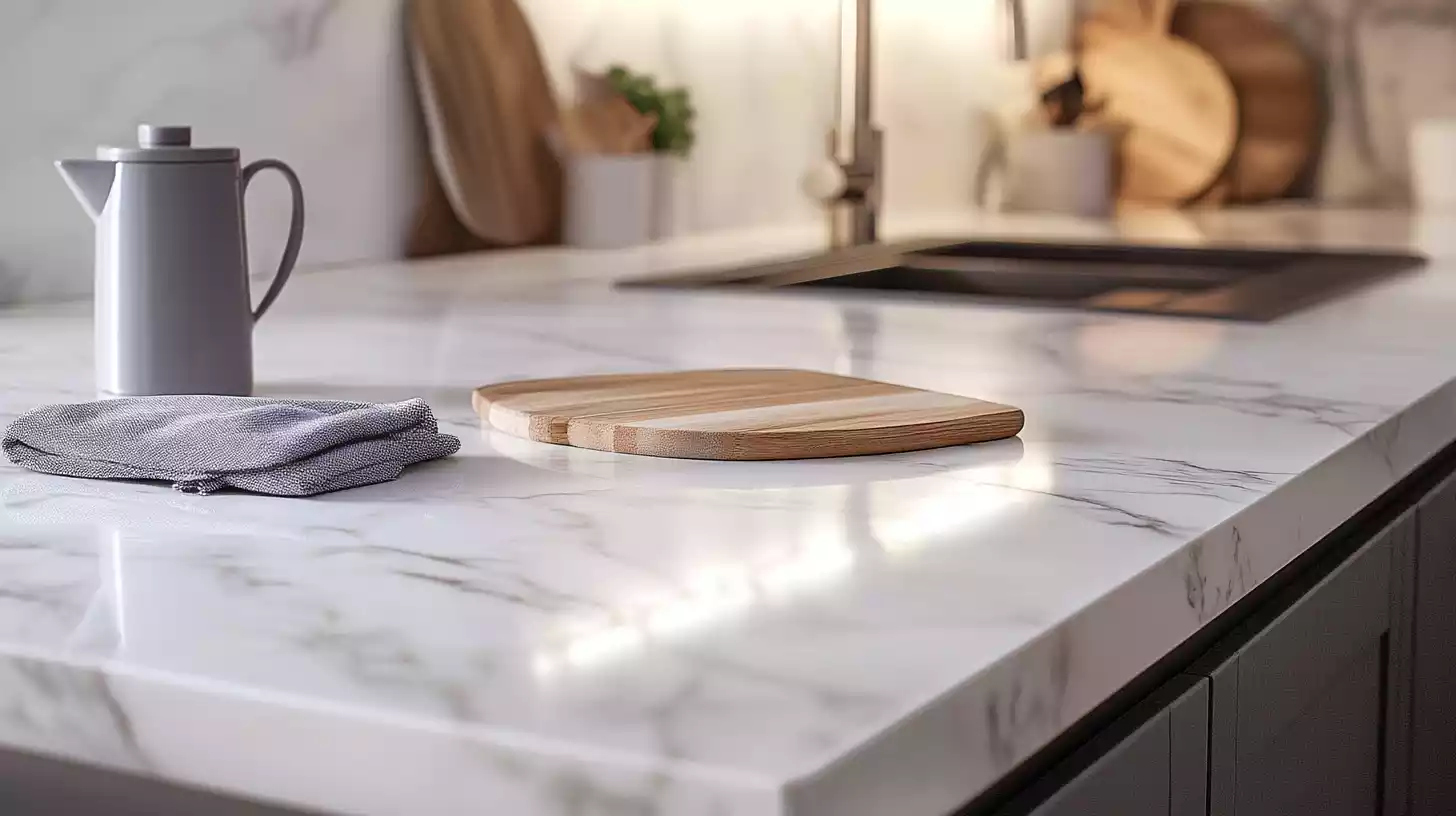I’ve learned the hard way that prevention is key to maintaining countertop appearance and longevity. Over the years, I’ve discovered five quick tips that have saved me from costly repairs and replacements.
These simple strategies have become second nature in my kitchen routine, and they’ve made a world of difference in preserving my countertops’ pristine condition.
If you’re looking to protect your kitchen investment and keep your surfaces looking as good as new, you’ll want to stick around for these game changing tips.
Quick Summary
- Use cutting boards to protect countertops from scratches and nicks caused by knives and other kitchen tools.
- Clean spills immediately to prevent staining and etching, especially with acidic substances like lemon juice or vinegar.
- Avoid placing hot pans directly on countertops by using trivets or hot pads to prevent temperature shock.
- Apply protective sealants regularly to create a barrier against stains, scratches, and wear and tear.
- Choose gentle, pH-neutral cleaning products to maintain countertops without causing damage from harsh chemicals or abrasives.

Use Cutting Boards
While it may be tempting to cut directly on your countertop, using cutting boards is essential for preventing damage. Trust me, I’ve learned this the hard way. Every time you slice, dice, or chop without a cutting board, you’re basically inviting scratches and nicks to your precious countertop. It’s like asking for trouble, and let’s face it, countertops aren’t cheap to replace.
I always keep a variety of cutting boards on hand. Wood, plastic, bamboo – they’re all better options than your bare counter. Don’t be lazy; just grab a board.
It takes two seconds and saves you a world of regret. Plus, it’s more hygienic. Think about all the bacteria that could be lurking in those little cuts you’re making.
Here’s a pro tip: get a few thin, flexible cutting mats. They’re easy to store and clean. Heck, you can even toss them in the dishwasher.
No excuses now!
Remember, your countertop isn’t invincible. Treat it right, and it’ll stay looking great for years. Use those cutting boards, folks. Your future self will thank you.
Clean Spills Immediately
Accidents happen, but when it comes to spills on your countertop, swift action is really important. I’ve learned this lesson the hard way, and you don’t want to make the same mistakes I did.
So, let’s get down to business. Regular cleaning and maintenance are pivotal to preventing countertop damage, and diligent spill management is key to keeping surfaces in top condition.
First things first, keep those cleaning supplies handy. You’ll thank me later. When a spill occurs, don’t dawdle – grab a cloth and wipe it up immediately.
If it’s water, no biggie. But if it’s something acidic like lemon juice or vinegar, you’ve got to move faster than a cat avoiding a bath. These nasties can etch your beautiful countertop in no time.
Don’t use just any old cleaner. Some surfaces are pickier than a toddler at dinnertime.
For granite or marble, stick to pH-neutral cleaners. Avoid anything abrasive – your countertop isn’t a scratching post. And please, for the love of all things shiny, don’t use bleach! It’s not your countertop’s best friend
Avoid Extreme Temperature Changes
Temperature shock is the silent enemy of countertops everywhere. I’ve seen too many beautiful surfaces ruined by careless hot pot placement or frozen food thawing. Let’s nip this problem in the bud, shall we?
My suggestion is to always use trivets or hot pads.
Don’t be a hero thinking your countertop can handle that scorching pan fresh from the oven. It can’t, and you’ll regret it. As for cold items, let them warm up a bit before plopping them down. Your countertop will thank you.
Here’s a quick guide to help you remember:
| Hot Items | Cold Items |
|---|---|
| Use trivets | Thaw gradually |
| Wait to cool | Use a barrier |
| Avoid direct | Avoid direct |
| contact | contact |
Look, I get it. You’re in a hurry, and it’s tempting to ignore these precautions. But trust me, the extra few seconds it takes to grab a trivet or let that frozen turkey thaw in the sink will save you a world of heartache (and a hefty replacement bill) down the road.
Your countertop isn’t invincible, so treat it with some respect, okay?
Apply Protective Sealants Regularly
Although many people overlook it, applying protective sealants regularly is crucial for maintaining your countertop’s longevity and appearance. I can’t stress this enough: don’t skimp on sealant!
It’s your countertop’s best friend, creating an invisible shield against stains, scratches, and general wear and tear. Regular sealing helps prevent damage from heat and moisture thermal shock and also prevents acidic substances from eating away at the countertop surface.
Depending on your countertop material, you’ll need to apply sealant every 6 to 12 months. Natural stone? Seal it more often. Engineered quartz? You might get away with less frequent applications. But don’t push your luck!
When it’s time to seal, clean your countertop thoroughly. No shortcuts here, folks. Apply the sealant evenly, following the manufacturer’s instructions. It’s not rocket science, but it does require some elbow grease. Let it dry completely before using your countertop again.
Choose Gentle Cleaning Products

I can’t stress enough how important this is for keeping your surfaces in tip-top shape.
Ditch those harsh chemicals and abrasive cleaners – they’re like sandpaper for your countertops, you don’t want that! For instance, marble countertops are especially prone to damage from acidic cleaners, so it’s vital to be extra cautious.
Solid wood countertops vary in price depending on the type of wood and layout, making it essential to choose the right cleaning products to maintain their quality.
Instead, opt for pH-neutral cleaners or make your own solution with mild dish soap and warm water. It’s not rocket science, folks. For tougher stains, mix baking soda with water to create a gentle paste. Apply it, let it sit for a few minutes, then wipe it off. Voila!
Avoid acidic cleaners like vinegar or lemon juice on natural stone surfaces. They’ll eat away at the stone faster than you can say “oops.” For daily cleaning, a damp microfiber cloth is your best friend. It’s gentle, effective, and won’t leave scratches


Loved the tip about using protective mats! I’ve just renovated my kitchen and am obsessed with keeping it looking pristine. It’s like, you spend all this money and time making it look beautiful, why wouldn’t you want to protect it? I’ve got these gorgeous, but functional mats that totally blend in. Anyone else have some stylish recommendations?
I found some great options on a site that specializes in kitchen gear. Look for ones that are heat-resistant and easy to clean.
hey, anyone knows if there’s a way to fix countertops after they get heat damage? asking for a friend who might’ve definitely not put a hot pan on theirs…
Regarding the section on avoiding direct heat, it cannot be stressed enough. Many homeowners underestimate the susceptibility of natural stone surfaces like granite or marble to thermal shock. It’s not just about aesthetic damage; it’s a structural integrity issue. And though some materials are more resistant, no countertop is immune. Always use trivets or heat pads.
cutting boards = a kitchen must have haha
Regular cleaning is crucial! I’m always on top of it.
While sealing countertops is mentioned, it’s important to highlight that not all materials require it. For instance, quartz is non-porous and doesn’t need sealing, unlike granite.
guess my countertop is more like a piece of abstract art now, what with all the scratches and stuff. gotta appreciate the unique beauty, right?